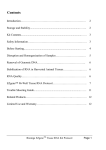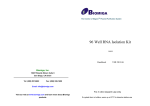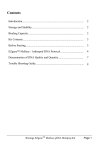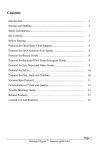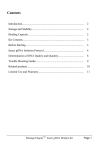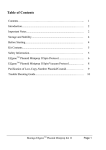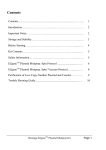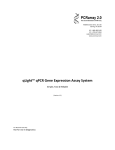Download Contents - Biomiga
Transcript
Contents Introduction.............................................................................................. 2 Storage and Stability................................................................................ 2 Kit Contents............................................................................................. 3 Before Starting......................................................................................... 4 Protocol For Extracting Total RNA From Mollusc……………………. 7 Trouble Shooting Guide………………………………………………... 10 Related Products………………………………………………………... 11 Limited Use and Warranty……………………………………………... 12 Page 1 TM EZgene Mollusk RNA Mini Kit Introduction The EZgene™ Mollusks RNA maxi Kit is designed for efficient recovery of total RNA greater than 200 nt from molluscs, roundworms, flatworms, and other invertebrate tissue samples rich in mucopolysaccharides. The procedure relies on the well established properties of the cationic detergent, cetyltrimethyl ammonium bromide (CTAB), in conjunction with the selective RNA binding of silica membrane. Samples are homogenized and lysed in a high salt buffer containing CTAB and extracted with chloroform to remove mucopolysaccharides and denature proteins. Following a rapid alcohol precipitation step, binding conditions are adjusted and RNA further purified using ezBind RNA spin columns. In this way salts, proteins and other contaminants are removed to yield high quality total RNA suitable for downstream applications such as reverse transcription, poly (A)+ mRNA selection, and hybridization techniques. Storage and Stability DNase I (optional) should be stored at -20°C. All other components can be stored at room temperature (22-25°C). All kit components are guaranteed for 1 year from the date of purchasing. Page 2 TM EZgene Mollusk RNA Mini Kit Kit Contents Catalog# R6619-00 R6619-01 R6619-02 Preps 4 50 250 ezBind Columns 4 50 250 Collection Tubes 8 100 500 4 50 250 Buffer BML 2 ml 20 mL 100 mL Buffer LY 4 mL 30 mL 130 mL Buffer RB 4 mL 45 mL 220 mL RNA Wash Buffer 2 mL 20 mL 54 mL DEPC-Treated ddH2O 500 µL 20 mL 70 mL DNase I Stop Buffer 400 µL 4.8 mL 24 mL 1.5 mL RNase-free microfuge tube User Manual 1 1 1 *DNase I and RNase Inhibitor not supplied. They could be purchased from Biomiga Safety Information Buffer LY contains chaotropic salts, which may form reactive compounds when combines with bleach, Do not add bleach or acidic solutions directly to the preparation waste, ware gloves and protective eyewear when handling. Page 3 TM EZgene Mollusk RNA Mini Kit Before Starting Prepare all components and get all necessary materials ready by examining this instruction booklet and become familiar with each steps. Important Determine amount of Buffer BML and Buffer LY to be used, add 20 µL β-mercaptoethanol (β-ME) per 1 mL Buffer BML or LY. Buffer BML and Buffer LY contains β-ME can be stored at room temperature for up to 1 month. β-ME is key in denaturing endogenous RNase. Add 8 mL (R6619-00) or 20 mL (R6619-01) or 216 mL (R6619-02) 100% ethanol to RNA Wash Buffer before use. The final concentration of 100% ethanol should be 80%. During shipment or storage under room temperature, crystal may form in certain buffers. Dissolve the precipitates at 37°C before use. Do not freeze the buffers at any time. Preheat the Buffer RB and DEPC-treated ddH2O (100 µL per sample) at 65°C. Optional: Add 600 µL (R6619-00) or 7.2 mL (R6619-01) or 36 mL (R6619-02) 100% ethanol to DNase Stop Buffer before use. Smaples: fresh tissue is preferred for RNA integrity. Materials supplied by users Tabletop microcentrifuge. 100% ethanol β-mercaptoethanol for denaturing the endogenous RNase. Chloroform and isoamyl alcohol (24:1) for removal of polysaccharides and proteins. Optional: DNase I Page 4 TM EZgene Mollusk RNA Mini Kit Avoiding RNase Contamination Please prepare materials as following instructions when working with RNA. 1. For RNA use only: Keep a separate set of pipettors for RNA use to avoid contamination with RNases. Avoid touching the barrel or metal ejector to the sides of tubes. 2. Solutions: Store solutions in small aliquots and discard each aliquot after use. 3. Electrophoresis apparatus: Wash with detergent solution, rinse in H2O, and dry with ethanol. Then fill with 3% solution of H2O2 (Don't use DEPC solutions because it will break down the plastic), incubate 10 mins at room temperature and rinse with DEPC treated H2O. 4. Glassware: Bake glassware at 300°C for 4 hours or 180°C or higher for several hours. Alternatively, soak glassware in freshly prepared 0.1% (v/v) DEPC in water or ethanol for 1 hour, drain, and autoclave (I t is necessary to destroy any unreacted DEPC which can otherwise react with other proteins and RNA). 5. Plasticware: Treat plasticware with DEPC. Use RNase-free disposable tips and tubes. Use sterile forceps to transfer items to racks. 6. Gloves: Use gloves from a fresh box at all times. Don't touch the gloves to any surface that might be contaminated with RNases. 7. Work carefully and quickly during the procedure. Page 5 TM EZgene Mollusk RNA Mini Kit Removal of genomic DNA using DNase digestion DNA digestion is necessary for downstream applications that are sensitive to very small amounts of DNA, for example, RT-PCR with low-abundance target. Generally, it is not required to do so since the EZgene RNA purification kit selectively isolates RNA and eliminates most of the DNA. If there is DNA contamination, either reduces the tissue amount or cell Stabilization of RNA in harvested animal tissues The intact of RNA in harvested tissue will be protected with the addition of RNASecure solution (Biomiga, catalog# R1011). 1. Cut the tissue into slices less than 0.5cm thick and immediately add at least 15 volumes of RNAsecure solution, for example, 150 uL RNAsecure solution per 10 mg tissue. 2. Store at room temperature for up to 24 hours, at 4°C for up to a week, and –20°C or –70°C for long term. RNA quality It is highly recommended that RNA quality be determined before downstream applications. The quality of RNA can be assessed by denatured agarose gel electrophoresis with the ethidium bromide staining. Several sharp bands should appear on the gel including 28S and 18S ribosomal RNA bands as well as certain populations of mRNA and bands. If these bands smear towards lower molecular weight RNAs, then the RNA has undergone major degradation during preparation, handling or storage, RNA molecule less than 200 bases in length do not efficiently bind to the RNA column. An A260/A280 ratio of 1.8-2.0 corresponds to 90-100% pure nucleic acid. Page 6 TM EZgene Mollusk RNA Mini Kit Protocol for Total RNA Extraction From Mollusks (Invertebrates) 1. Grind no more than 30 mg tissue in liquid nitrogen with mortar and pestle and transfer the powder into a clean 1.5 ml microcentrifuge tube. Note: The procedure could be scaled up with the increase of starting material and volumes of all buffers. With RNA binding capacity of 100 µg, tissue more than 50 mg is not suggested. Less tissue or more buffer is suggested for hard -to-lysis tissue. I. Quick protocol: follow step 2 to 4, and proceed to step 10. 2. Add 350 µL Buffer LY (Add β-ME before use) and vortex vigorously to make sure that all clumps are dispersed. Note: Complete dispersion is critical for RNA extraction. 3. Centrifuge 10,000 x g for 2 min at room temperature. Carefully transfer the supernatant to a clean 1.5 ml microfuge tube. Avoid the milky interface containing contaminants and inhibitors. 4. Add 350 µL 100% ethanol and mix by sharp hand shaking. II. Suggested but not mandatory protocol: follow step 5 to 9, and proceed to step 10. 5. Add 350 µL Buffer BML (Add β-ME before use) and vortex vigorously to make sure that all clumps are dispersed. Note: Complete dispersion is critical for RNA extraction. 6. Add 350 µL chloroform:isoamyl alcohol (24:1) and vortex to mix. Centrifuge 10,000 x g for 2 min at room temperature. Carefully transfer Page 7 TM EZgene Mollusk RNA Mini Kit the supernatant to a clean 1.5 ml microfuge tube. Avoid the milky interface containing contaminants and inhibitors. Note: This step will remove much of the polysaccharides and proteins from solution and improve the downstream application. 7. Add 1 volume of isopropanol and mix to precipitate RNA. Immediately centrifuge 10,000 x g for 2 min at room temperature. Remove the supernatant completed (Avoiding disturbing RNA pellet). Invert the microfuge tube on a paper towel for 1 min to allow residual liquid to drain. 8. Add 100 µL of Buffer LY (Add β-ME before use, and pre-heated to 65°C) and vortex to resuspend the pellet. Note: Pre-heating the buffer to 65°C is necessary to effectively dissolve the RNA. 9. Add 350 µL Buffer LY (Add β-ME before use) and 250 µL 100% ethanol and mix by sharp hand shaking. 10. Immediately apply the entire mixture (including any precipitation) to the DNA column with collection tube. Centrifuge 10,000 x g for 15 sec at room temperature to let the solution pass through the column. Discard the flow-through liquid and reinsert the column into the collection tube. 11. Optional: Add 50 µL DNase I (2U,RNase-free) solution onto the middle of the column and incubate at room temperature for 15 min. Add 200 µL DNase Stop Buffer onto the column and centrifuge at 14,000 rpm for 1 min. Discard the flow-through. 12. Add 500 µL Buffer RB and centrifuge at 10,000 x g for 15 sec. Discard the flow-through liquid and collecting tube. Page 8 TM EZgene Mollusk RNA Mini Kit 13. Place the column in a clean 2 mL collection tube, and add 500 µL RNA Wash Buffer (Add ethanol before use). Centrifuge at 10,000 x g for 15 sec at room temperature and discard flow-through and reinsert the column into the collection tube. Repeat this step. 14. Centrifuge the DNA column for 2 min at full speed to completely dry the ethanol remain on the membrane. Note: Complete removal of residual ethanol is critical for RNA elution. 15. Transfer the column to a clean 1.5 ml microfuge tube. Add 50-100 µL of DEPC-Treated ddH2O to the center of the membrane to elute the RNA. Centrifuge 1 min at maximum speed. 80% RNA is recovered with first elution. 16. Optional: A second elution will increase the yield while lower the Note: For higher RNA concentration, reload the first eluate for the second elution. 17. Determine the concentration and purity of RNA, measure absorbance at 260 nm and 280 nm in a spectrophotometer. A ratio of 1.8-2.0 corresponds to 90%-100% pure nucleic acid. Store RNA samples at 70°C in water. Page 9 TM EZgene Mollusk RNA Mini Kit Trouble Shooting Guide Problems Possible reasons Suggested Improvements Low A260/A280 ratios Protein contamination Do a Phenol: Chloroform extraction. Loss of total RNA (up to 40%) should be expected. Low A260/A280 ratios Guanidine Thiocyanate contamination Add 2.5 volumes of ethanol and 0.1M NaCl (final concentration) to precipitate RNA. Incubate for 30 min at -20 ℃. Centrifuge at 10,000 g for 15 min at 4°C Resuspend the RNA pellet in DEPC-treated water. Low Yield RNA in sample degraded Freeze samples immediately in liquid nitrogen and store at -70°C after collect it. Low yield RNA remains in the column Pre-heat DEPC-treated ddH2O and repeat elution. Low Yield The binding capacity of the membrane in the spin column was exceeded Use of too much tissue sample exceeding the binding capacity of spin column will cause the decreasing of total RNA yield. Low Yield Ethanol not added to buffer Add ethanol to the RNA Wash Buffer and DNase Stop Solution before purification. Genomic DNA contamination Too much total RNA Reduce total RNA amount used in RTsample was used in RT- PCR to 50-100 ng. PCR. Genomic DNA contamination The sample may contain Reduce the amount of starting tissue in too much genomic the preparation of the homogenate. DNA. Most tissues will not show a genomic DNA contamination problem at 30 mg or less per prep. Increase buffer volume and do multiple loadings to column. Page 10 TM EZgene Mollusk RNA Mini Kit Related EZgeneTM Products Catalog # Product Name Preps Price $ R6311-01 Tissue RNA kit 50 150.00 R6311-02 Tissue RNA kit 250 650.00 R6312-01 Tissue RNA midi kit 10 80.00 R6312-02 Tissue RNA midi kit 20 160.00 R6314-01 Tissue RNA maxi kit 10 120.00 R6314-02 Tissue RNA maxi kit 25 270.00 R6315-01 Tissue RNA mega kit 2 120.00 R6315-01 Tissue RNA mega kit 10 580.00 R6811-01 96-well tissue RNA kit 4x96 780.00 R6811-02 96-well tissue RNA kit 20x96 3300.00 R6411-01 Blood RNA mini kit 50 150.00 R6411-02 Blood RNA mini kit 250 680.00 R6412-01 Blood RNA midi kit 10 80.00 R6412-02 Blood RNA midi kit 25 180.00 R6414-01 Blood RNA maxi kit 10 120.00 R6414-02 Blood RNA maxi kit 25 270.00 R6812-01 96-well blood RNA kit 4x96 780.00 R6812-02 96-well blood RNA kit 20x96 3500.00 Page 11 TM EZgene Mollusk RNA Mini Kit Limited Use and Warranty This product is warranted to perform as described in its labeling and in Biomiga’s literature when used in accordance with instructions. No other warranties of any kind, express or implied, including, without limitation, implied warranties of merchantability or fitness for a particular purpose, are provided by Biomiga. Biomiga’s sole obligation and purchaser’s exclusive remedy for breach of this warranty shall be, at the option of Biomiga, to replace the products, Biomiga shall have no liability for any direct, indirect, consequential, or incidental damage arising out of the use, the results of use, or the inability to use it product. For technology support or learn more product information, please visit our website at www.biomiga.com or contact us at (858) 603-3219. Page 12 TM EZgene Mollusk RNA Mini Kit












